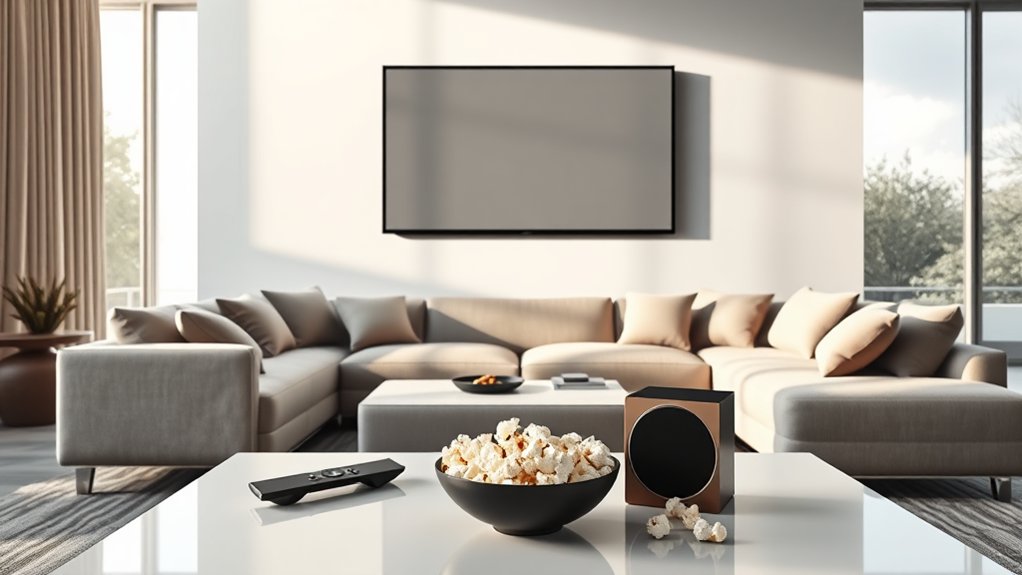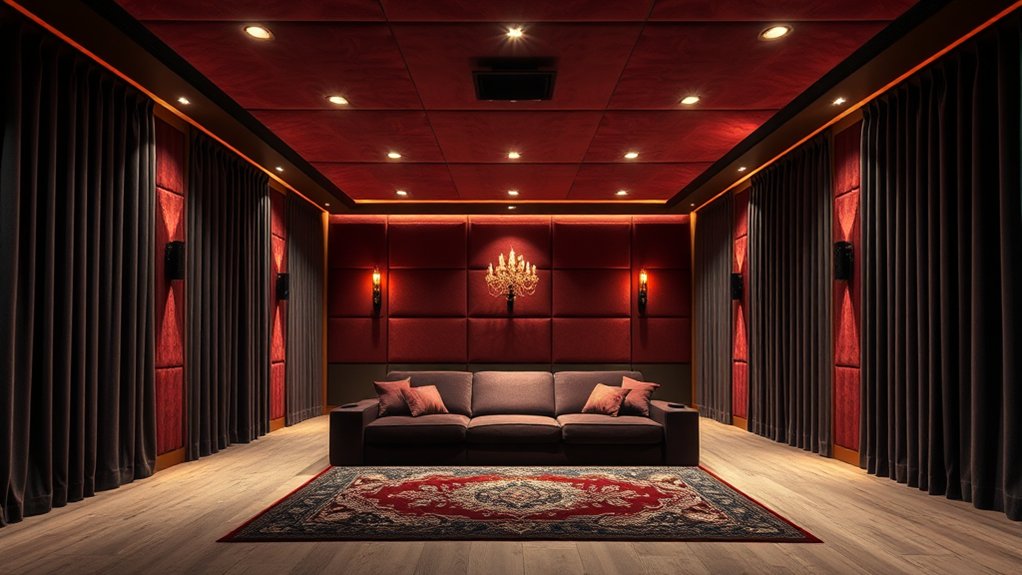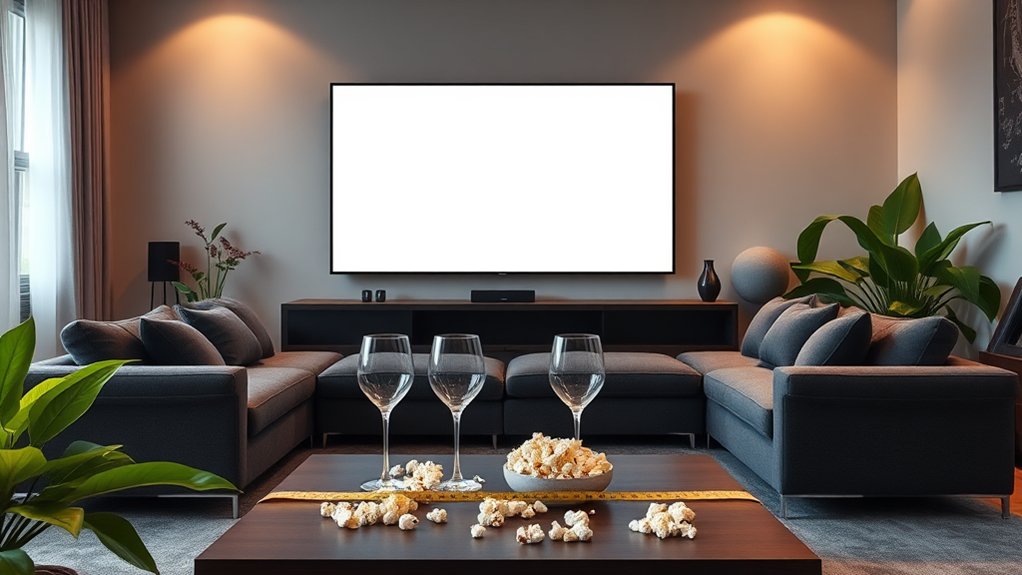When setting up a wireless home theater, it’s crucial to pick the right display technology—LCDs are budget-friendly whereas OLEDs offer stunning colors and blacks. Optimize your system’s wireless performance by choosing RF over Bluetooth for lower latency; obstructions can really ruin the experience. Improve audio with surround sound setups, ensuring your speakers are positioned correctly. Don’t forget to take into account brand reliability and compatibility with your devices, as these factors can make or break the entire system. Curious about projectors? You might find the perfect fit if you keep going!
Key Highlights
- Choose display technology based on your environment: LCD for bright rooms, OLED for deep blacks, and MicroLED for premium quality.
- Opt for RF transmission systems over Bluetooth for lower latency and better performance in wireless home theater setups.
- Ensure devices are positioned for optimal sightlines and minimal interference from other electronics to maintain connectivity.
- Select a sound system that supports surround sound options and consider wireless subwoofers for clutter-free setups and enhanced bass.
- Verify brand compatibility with streaming platforms and smart home technologies to ensure seamless integration and user experience.
Choose the Right Display Technology
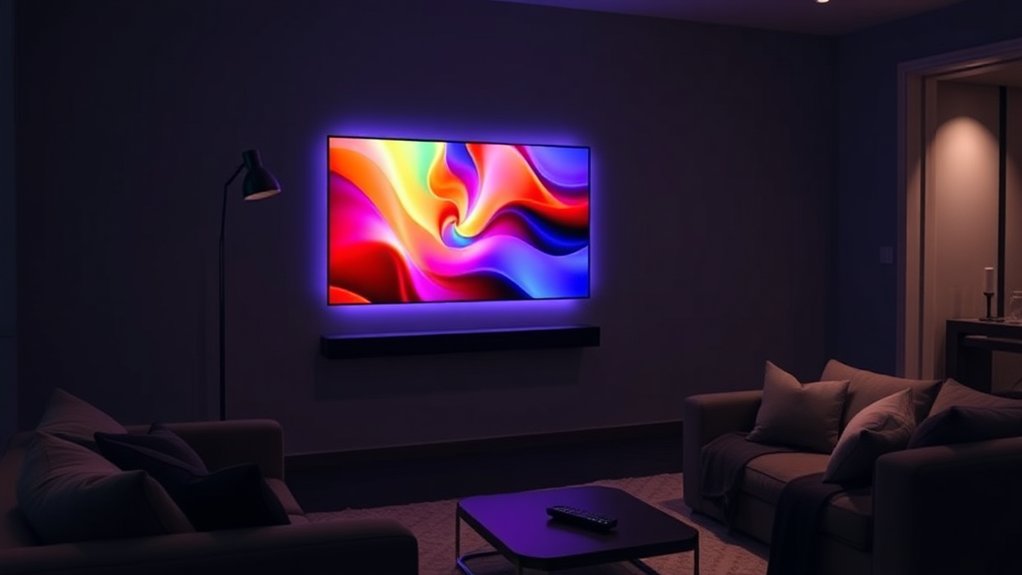
When you’re diving into the world of wireless home theater displays, it’s essential to choose the right display technology, especially since it can make or break your viewing experience. You have several options—LCD displays are great for bright rooms and budget-friendly, whereas OLED screens shine with deep blacks and superb color accuracy. If you’re ready to splurge, MicroLED offers high brightness and impressive longevity, though it comes at a premium. Don’t overlook projection systems, especially ultra-short-throw projectors that can fill a wall with stunning imagery. Wireless home theater systems simplify the setup process, creating a more organized viewing environment. Each technology impacts picture quality and performance differently, so consider your space and viewing preferences. After all, who wouldn’t want a cinema-like experience right in their living room? Additionally, it’s crucial to keep power draw in mind when selecting a display, as more powerful technologies may lead to higher electricity costs over time.
Optimize Wireless System Performance and Connectivity
Are you tired of audio dropouts or video lag ruining your wireless home theater experience?
To improve performance, start by choosing RF transmission systems instead of Bluetooth. RF offers lower latency, keeping your audio and video in sync. Additionally, WiSA-enabled products can offer high-quality audio with capabilities of uncompressed sound, making them an excellent choice for wireless setups. The Sonos Arc is an example of a device that enhances audio experiences with Dolby Atmos support. Properly check speaker connections to ensure that all components are paired correctly for optimal performance.
Next, position your transmitters and receivers in clear sightlines—obstructions like walls or furniture can block signals.
Position transmitters and receivers in clear sightlines to avoid obstructions like walls or furniture that can disrupt signals.
Avoid placing devices near other electronics that can cause interference; think microwaves and crowded Wi-Fi networks. Choosing systems on the less congested 5 GHz band can additionally help.
Regularly updating your firmware is essential, too, as it boosts connectivity reliability.
Finally, confirm all receivers are powered adequately, as even wireless speakers need individual power sources for peak performance.
Who knew wireless could require so much wiring?
Enhance Sound Quality With Surround Sound Options
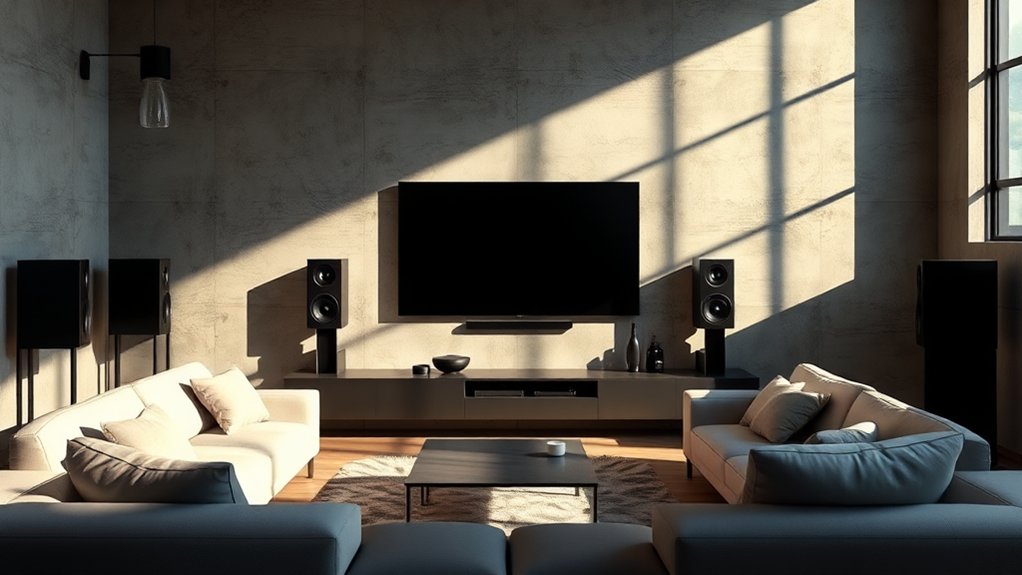
Surround sound systems improve your home theater experience, transforming ordinary movie nights into immersive cinematic adventures. With configurations like 5.1, 7.1, or even more complex setups, you can enjoy sound that wraps around you. For instance, a 7.1 system adds speakers behind you, ensuring every gunshot or whisper feels realistically positioned. Plus, wireless subwoofers boost your bass without cluttering your space. Don’t forget about soundbars packed with satellite speakers, as they simplify your setup—no more tripping over cables! The Sony HT-A7000 soundbar, with its 7.1.2 channel surround sound, offers exceptional audio quality that enhances your viewing experience. Properly positioning your speakers—ear height and angles of 135 to 150 degrees—gives you crisp sound across the room, while investing in quality equipment improves overall audio performance.
Adapt Screen and Room for Ideal Viewing
To guarantee an enjoyable viewing experience, it’s crucial to adapt both your screen and room for the ideal setup, especially since nobody appreciates craning their neck or squinting to see the action on screen.
Start by determining your best screen size based on your viewing distance; for instance, if you sit 10 feet away, aim for a 100″ screen.
Next, consider the aspect ratio. If you’re mostly watching modern content, a 16:9 screen is perfect, whereas cinematic enthusiasts might prefer 2.35:1.
Don’t forget about seating—keeping your chairs within a 30 to 36-degree angle of the screen can make a world of difference.
Finally, adjust your room’s lighting to improve visibility. After all, no one wants glare ruining the latest blockbuster!
Consider Brand and Ecosystem Compatibility
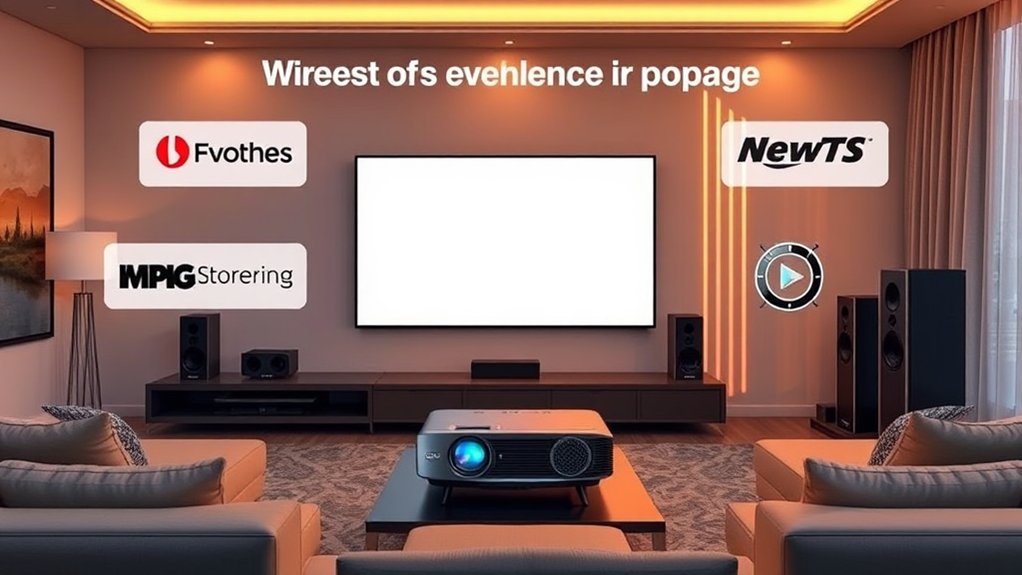
When examining the world of wireless home theater displays, it’s vital to take into account the brand and ecosystem compatibility, especially since no one wants to invest in equipment that doesn’t blend smoothly with their existing setup.
Established brands tend to offer higher quality and reliability, making them a safer bet for your investment.
Investing in established brands often ensures superior quality and dependable performance for your home theater setup.
Think about how fluidly devices integrate; a system that plays well with your streaming platforms and smart home tech improves convenience and minimizes those dreaded connectivity issues.
Plus, if a brand offers regular firmware updates, you’re securing the longevity of your system. Additionally, choosing a soundbar that supports Dolby Atmos can significantly enhance your overall audio experience, making it an essential feature to consider.
Simplify Installation and Usability
After you’ve navigated the maze of brand compatibility, the next step is making certain your wireless home theater display is a breeze to install and use.
Look for models with built-in Wi-Fi; this not only spares you from juggling multiple adapters but likewise keeps your setup neat.
Opt for displays featuring intuitive, automatic pairing—after all, who wants to fumble through long manual setups?
On-screen menus can guide you through connections effortlessly.
Finally, consider the strategic placement of your devices and speakers; ensuring minimal obstructions can improve signal strength and sound quality.
Evaluate Projector and Screen Integration
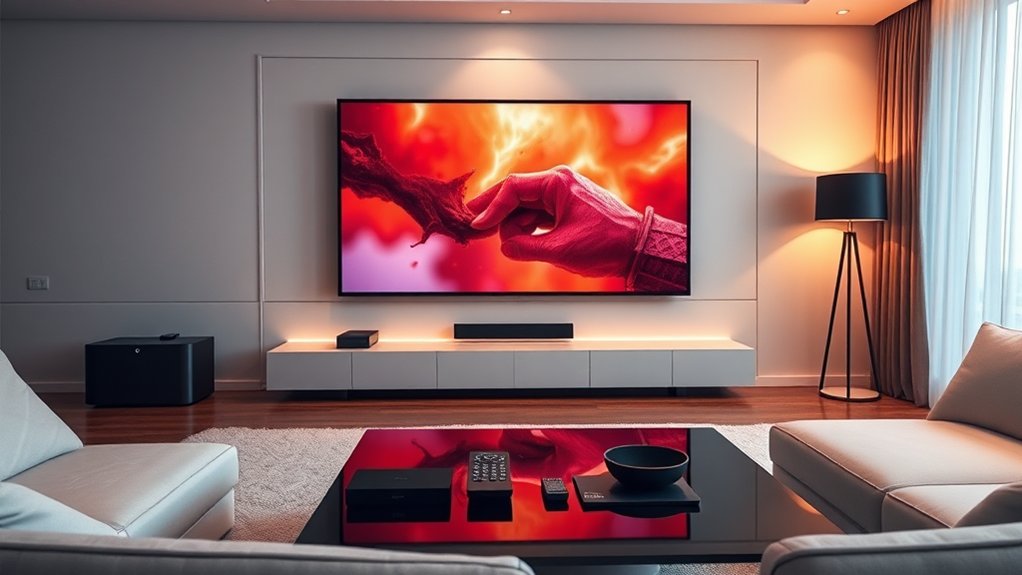
Integrating a projector and screen effectively can make a world of difference in your home theater experience, especially when you consider how critical visual quality is for immersing yourself in your favorite movies.
You’ll want to guarantee compatibility between your projector and surround sound system, ideally using eARC or ARC ports.
Wireless kits, like those from AWOL ThunderBeat, can simplify setup by transmitting audio without messy cables.
Nonetheless, keep in mind that sound and video must sync perfectly; otherwise, you’ll be left wondering why the villain’s lips don’t match their evil plans.
Placement matters too, as room acoustics impact sound immersion.
Ultimately, testing different setups can lead to the best possible integration for your space (and avoid future “what was I thinking?” moments).
Frequently Asked Questions
How Do I Choose the Right Size Screen for My Room?
To choose the right screen size for your room, measure your viewing distance. Multiply it by 0.835 for an immersive experience, or by 0.65 for mixed use, ensuring it fits comfortably within your space.
Can I Use My Existing Sound System With a New Projector?
Yes, you can use your existing sound system with a new projector. Just check for compatible ports, and consider using an AV receiver for better audio routing. Confirm everything connects properly for peak performance.
What Accessories Are Essential for a Wireless Home Theater Setup?
For a wireless home theater setup, you’ll need a wireless subwoofer, surround sound speakers, a high-definition display, streaming devices, and a universal remote. Don’t forget HDMI cables and power accessories for ideal performance and connectivity.
How Do I Maintain My Home Theater Equipment?
To maintain your home theater equipment, regularly clean surfaces, update software, check connections, and guarantee good ventilation. Turn off devices when not in use, and avoid dust and humidity to extend their lifespan.
What Are Common Troubleshooting Steps for Connection Issues?
To troubleshoot connection issues, you should check all power and cable connections, verify device functionality, reset problematic devices, and isolate audio/video problems. Consider network diagnostics if multiple devices face issues to identify the root cause.

